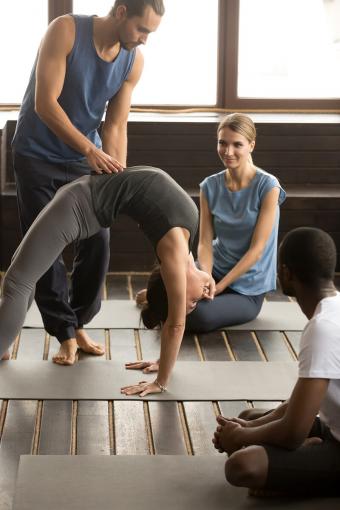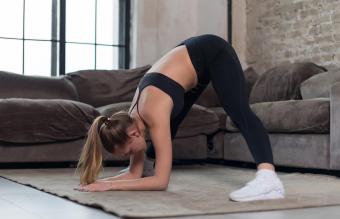
Yoga inversions are poses or asanas where the head is below the heart. Some yoga inversions are challenging because they require your body to be completely upside down. A handstand, for example, requires upper body strength, core stability, and balance. But there are also beginning-level inversions that you can try. For instance, downward facing dog is an easy inversion that is included in many beginner-level yoga flows.
Yoga practitioners often include inversions in their daily practice for the benefits that they feel when they master the poses. Inversions are believed to improve circulation, increase energy, and improve overall balance and coordination. Research is just beginning to touch the surface regarding the physical and psychological benefits of yoga inversions. Learning more about these potential health advantages may inspire you to include them in your yoga habit.
5 Yoga Inversion Benefits
According to a 2011 study published in the International Journal of Yoga, a typical yoga practice can increase blood-flow, oxygenate your organs, reduce physical tension, and lower stress levels. Together, these results can minimize the chances of developing health conditions and illnesses like hypertension, chronic pain, or even cancer. Inversions have been shown to deepen those benefits due to their rigorous nature.
Enhanced Physical Fitness
One of the most widely known benefits of an inversion practice is the way it enhances physical fitness through improved flexibility and increased muscular strength. While each pose confers multiple benefits, common inversions are used to target certain areas.

- Stretch and lengthen your hamstrings and back with downward facing dog, standing forward bend, or plow.
- Build and tone your shoulders via headstand, handstand, or dolphin.
- Open your abdominals and work the muscles of your back with scorpion or wheel pose.
All of this adds up to a stronger, more mobile physical body. To get in shape through inversions, add them to your practice at least twice a week. Challenge yourself by holding poses for three to five breaths longer than you usually feel comfortable with to help build your endurance.
Increased Heart Rate Variability
There's only one study to date that shows a significant difference between the rewards of a standard yoga practice versus a practice of inversions. The 2013 study, published in the journal BMC Research Notes, found that a regular inversion practice contributed to increased heart rate variability (HRV), or variations in the pace at which your heart beats. According to researchers, this can lead to a number of positive effects over the long term. Having a higher HRV is generally an indicator of better cardiovascular fitness and may make you more resiliant to stress.
Better Immune Function
Those who suffer from lowered immune function are more susceptible to illness than those who maintain a healthy one. Exercise can affect immunity drastically by building a force of antibodies that help you fight off viruses and other foreign substances. Since inversions typically involve arm balancing, which can take more physical exertion, they are the ideal yoga poses for boosting immunity.
Boost your immunity by building up a sweat during your practice. PubMed scientists write that the build-up of heat in your body and the expulsion of liquids (through perspiration) serves to kill germs and eject them from your body.
Lower Daily Stress Levels
Yoga is commonly used for stress management. Inversions in particular strengthen the yogi's ability to remain calm under stress. Because they can be physically challenging, it's easy to tense your muscles during inversions. Instead, see if you can find a bit of softness by only engaging muscles that are necessary to stay solid in each pose. Relax everything else and focus on maintaining steady breathing.

Yoga provides an outstanding workout while also improving flexibility. Both exercise and stretching are known to reduce stress levels for several reasons. Examples include:
- Increased blood circulation throughout the body, leading to improved energy levels
- Reduced pain through increased joint mobility and the release of tension caused by tight muscles
- Improved ability to manage breathing, as in pranayama practice, which can help lower heart rate and reduce blood pressure
Promotes Feelings of Positivity
As indicated in a 2012 article published in the journal Evidence-Based Complementary and Alternative Medicine, those who maintain a consistent inversion practice report higher levels of well-being than those who don't practice at all. Researchers indicate that consistency was the key to boosting well-being. The longer participants maintained the ritual, the more positively they rated their lives. What does this mean for you? Whether you practice twice a week or five times a week, stick with it for the long haul and you're likely to keep those good feelings with you too.
This finding isn't unique to inversions. Rather, it is consistent across multiple mind-body modalities, such as asana practice, meditation, and even philosophical study. This doesn't belittle the finding for inversions, but rather gives those who prefer more intensity in their mind-body practice a way to meet their need for a challenge.
Tips for Building a Safe Inversion Practice
A 2013 report published in PLOS One noted that inversions account for a significant number of injuries during yoga practice, due to improper form, lack of strength, or inexperience. While these poses are often encouraged in all levels, they are not appropriate for everyone. The poses may come easily for those who have an athletic background or have been practicing yoga for some time, but advanced inversions can be dangerous for beginners. If you're truly committed to trying yoga inversions, it's better to be safe than sorry.

- Stick to beginner inversions until you have mastered them and built the strength necessary to try more challenging options.
- If you are new to yoga or inversions, take classes from an instructor who will take time to break down each step of the process.
- For challenging inversions, work one-on-one with a certified yoga teacher who can help you maintain proper form and correct any faults.
It is important to take your time when learning yoga inversions. You'll enhance your physical, emotional, and psychological health by adding these asanas to your existing routine. But it will take consistency and practice to reap the benefits of yoga inversions.
Build a stronger body, increase your endurance, boost your immunity, lower your stress levels, and feel more positive on a daily basis simply by going upside down. Just make sure to stay safe by starting with inversions appropriate for beginners and working your way up to more advanced options.







